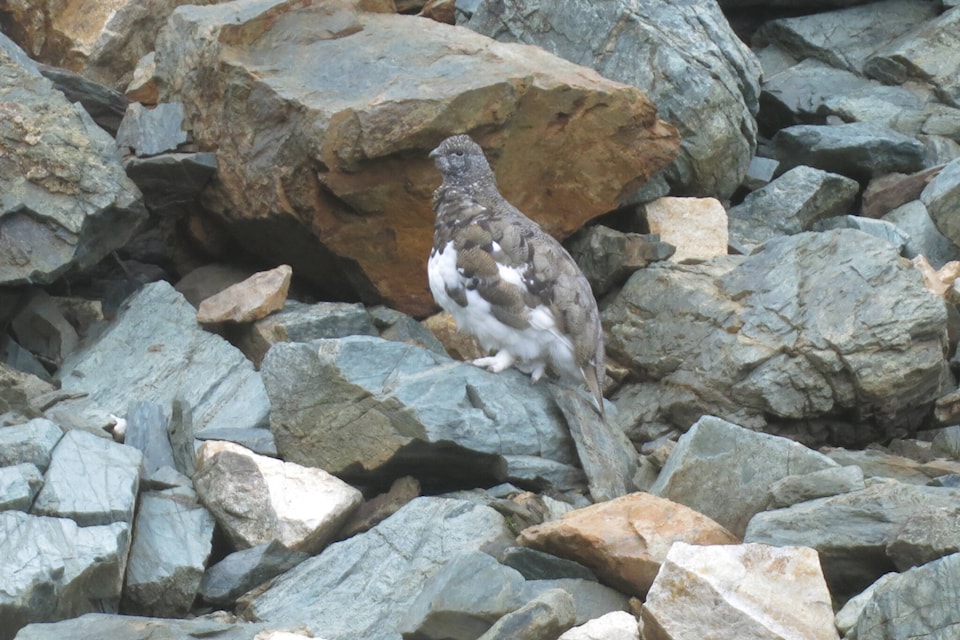By Ed McMackin, biologist by profession and naturalist by nature
The ruffed grouse is quite familiar to many people of the Kootenay Lake region, as well as to most people who live in rural settings across temperate North America. Also in the family, is the spruce grouse which inhabits coniferous forests at higher altitudes, and the dusky grouse, which inhabits montaine forests and open ponderosa pine and Douglas fir forest, with patches of open, bedrock, wet-in-spring slopes. These birds don’t migrate in the usual sense of the term. They’ve adapted to thrive in cold weather and deep snow. In fall and winter, they will move around, sometimes to a lower elevation to suit their food and shelter requirements.
Probably the least familiar members of the grouse family are the ptarmigans. Willow ptarmigans inhabit the arctic and sub-arctic zones of the far north, having a range similar to that of the rock ptarmigan, which inhabits high mountain slopes. The most familiar species to high-country hikers are white-tailed ptarmigans, which are the common ptarmigans in the Kootenay Lake region.
Not too many have personally encountered white-tailed ptarmigan in our local Kootenay Mountains. But they have been seen on the south, vegetated slopes of the Sphinx Range and on the south aspects of Mount. Brennan, north of Retallack, B.C.
From what I have observed, white-tailed ptarmigan seem to occupy mountains of around 8500 ft. elevation or more. Sphinx is about 8500 ft. and Brennan is around 9300 ft. Once, in the early morning, on the top of Sphinx, I heard a soft clucking beside the tent. Sticking my head out, I saw a female escorting three little chicks around, from plant to plant, nipping here and there at a leaf.
In early September, we encountered six or more at about 9000 ft. on the trail to Mount. Brennan’s summit. It was kind of cool and windy, with a little sun, and a group of white-tailed ptarmigans were roaming about in this sheltered trench feeding on buds, leaves, and flowers of plants among the rocks. It was likely 30 minutes before we saw most of them. They were hard to spot on around the rocks that came close to matching the colours of their plumage. Only when one moved, and we started checking every rock, did we see more. They didn’t fly away but some hopped from rock-to-rock or ran over the rocks then we got too close. When we were watching them, one came out from a rock.
Still, in early September, I went up a second time and saw the same flock in the same sheltered location. I watched one feed on the leaves and buds of a red monkey flower. The flock will likely stay in the same area for the winter. The lee-side of the rocks (sheltered from the wind), even with two feet of snow, would have accessible plants and suitable shelter. The white-tailed ptarmigan are covered in all-white plumage for the winter, including “leggings” and soft feathers between and over their toes. Dressed in this way, they can be very camouflaged and hard to see on top of the snow.
Ptarmigan and other members of the grouse family (including turkeys and pheasants) usually nest on the ground, except for the very odd grouse that nests in a thick conifer. Ptarmigan and grouse young are ready to run right after they hatch.
One reason why hikers don’t get a good look at ptarmigan and other alpine creatures is because, in their hurry to get to the top, they will have a free-running dog that will scare away any wildlife. (Please keep your dogs leashed while on trails, or anywhere else.)
On the lower forested portion of the Whitewater Basin Trail we spotted a hen grouse resting on the side of the trail. When, within a few feet of her she stood up, raised her wings a bit, and six or so little chicks magically appeared.
All kinds of surprises await the adventurer “out there”. As winter approaches, dress warm and suitable for the weather and remember there is not a bear behind every tree waiting to pounce on you.
READ MORE: Out There: Praying Mantises on the Fly
